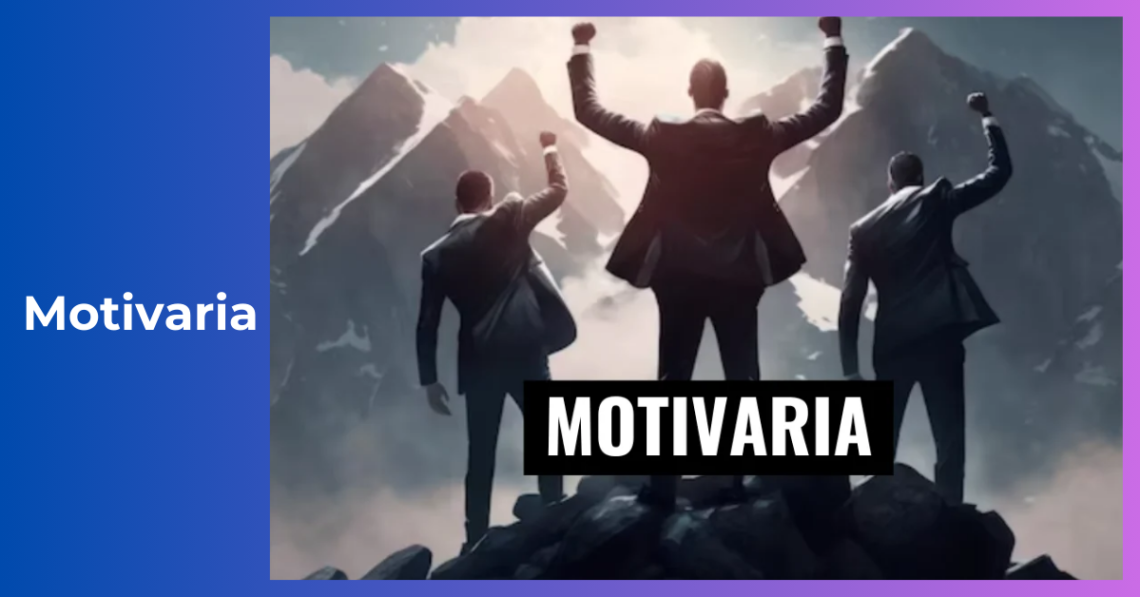
Motivaria _ Unraveling the Complex Web of Personal and Professional Motivation
Motivaria stands as a beacon of light in the realm of personal and professional development.
It encompasses the intricate web of motivations that drive human behavior, influencing every aspect of our lives.
Motivaria illuminates the complex motivations driving personal and professional growth. It explores how understanding these motivations can enhance fulfillment and success, guiding individuals to achieve their goals and excel in their endeavors.
In this comprehensive article, we will delve into the essence of Motivaria, explore its various facets, and provide valuable insights that go beyond existing sources.
Whether you are striving for personal growth or aiming to enhance your professional life, understanding Motivaria is crucial for unlocking your full potential.
What is Motivaria?
Motivaria is a term that combines “motivation” with “area,” symbolizing the diverse and interconnected aspects of motivation that influence human behavior.
It represents the comprehensive study of what drives individuals to take action, pursue goals, and achieve success.
From intrinsic motivations like passion and curiosity to extrinsic motivations like rewards and recognition, Motivaria encompasses the entire spectrum of factors that inspire people to strive for excellence.
The Foundations of Motivation
Intrinsic Motivation
Intrinsic motivation refers to the internal drive that comes from within an individual.
It is fueled by personal interests, passions, and the inherent satisfaction derived from engaging in a particular activity.
Intrinsic motivation is often linked to creativity, self-expression, and a deep sense of fulfillment.
Examples of Intrinsic Motivation:
- Pursuing a hobby for sheer enjoyment
- Learning a new skill out of curiosity
- Volunteering for a cause you believe in
Extrinsic Motivation
Extrinsic motivation, on the other hand, is driven by external factors such as rewards, recognition, and societal expectations.
It involves performing tasks to achieve tangible outcomes or avoid negative consequences. While extrinsic motivation can be effective in the short term, it may not always lead to long-lasting satisfaction.
Examples of Extrinsic Motivation:
- Working for a salary or bonus
- Studying to get good grades
- Competing in sports for trophies and medals
The Balance Between Intrinsic and Extrinsic Motivation
Finding the right balance between intrinsic and extrinsic motivation is essential for sustained success and well-being.
While extrinsic rewards can provide initial incentives, intrinsic motivation is often the key to maintaining long-term passion and commitment.
The Science Behind Motivaria
Psychological Theories of Motivation
Several psychological theories provide valuable insights into the mechanisms of motivation.
Also Read : COFEEMANGA _ A CULTURAL FUSION OF COFFEE AND MANGA
Understanding these theories can help us better comprehend the complex nature of Motivaria.
Maslow’s Hierarchy of Needs
Abraham Maslow’s hierarchy of needs is a widely recognized theory that categorizes human needs into a pyramid structure.
According to Maslow, individuals must satisfy lower-level needs before they can focus on higher-level motivations.
Levels of Maslow’s Hierarchy of Needs:
- Physiological Needs (food, water, shelter)
- Safety Needs (security, stability)
- Love and Belongingness (relationships, social connections)
- Esteem Needs (self-respect, recognition)
- Self-Actualization (personal growth, fulfillment)
Self-Determination Theory
Self-Determination Theory (SDT), developed by Edward Deci and Richard Ryan, emphasizes the importance of autonomy, competence, and relatedness in fostering intrinsic motivation.
According to SDT, individuals are most motivated when they feel in control of their actions, capable of achieving their goals, and connected to others.
Goal-Setting Theory
Goal-Setting Theory, proposed by Edwin Locke and Gary Latham, highlights the significance of setting specific, challenging, and achievable goals.
The theory suggests that clear goals provide direction and motivation, leading to higher performance and satisfaction.
Neuroscience of Motivation
Recent advancements in neuroscience have shed light on the brain’s role in motivation. Dopamine, often referred to as the “reward chemical,” plays a crucial role in the brain’s reward system.
When we achieve a goal or experience a positive outcome, dopamine is released, reinforcing the behavior and motivating us to repeat it.
Practical Applications of Motivaria
Personal Development
Understanding Motivaria can significantly enhance personal development by helping individuals identify their core motivations and leverage them for growth.
Setting Meaningful Goals
Setting meaningful and attainable goals is a cornerstone of personal development. By aligning goals with intrinsic motivations, individuals can stay committed and driven, even in the face of challenges.
Cultivating a Growth Mindset
A growth mindset, as coined by psychologist Carol Dweck, involves believing in the potential for personal growth and development.
Embracing a growth mindset can increase resilience, encourage continuous learning, and enhance motivation.
Professional Development
In the professional realm, Motivaria plays a vital role in career advancement, job satisfaction, and overall productivity.
Enhancing Employee Motivation
Organizations can benefit from understanding Motivaria by creating environments that foster both intrinsic and extrinsic motivation.
Recognizing employees’ achievements, providing opportunities for skill development, and promoting a positive work culture can boost morale and performance.
Leadership and Motivation
Effective leadership involves inspiring and motivating team members to achieve their best.
Leaders who understand Motivaria can tailor their approaches to meet the diverse motivational needs of their teams, leading to increased engagement and success.
The Role of Motivation in Overcoming Challenges
Dealing with Procrastination
Procrastination is a common barrier to productivity and success.
By understanding the underlying motivations for procrastination, individuals can develop strategies to overcome it.
Breaking tasks into smaller, manageable steps and finding intrinsic rewards in the process can help combat procrastination.
Building Resilience
Resilience is the ability to bounce back from setbacks and persevere in the face of adversity.
Motivation is a key component of resilience, as it provides the inner strength and determination needed to overcome challenges.
Cultivating a resilient mindset involves focusing on long-term goals and maintaining a positive outlook.
The Future of Motivaria
Technological Advancements
As technology continues to evolve, new tools and platforms are emerging to enhance motivation and personal development.
From mobile apps that track progress and provide personalized feedback to virtual reality experiences that simulate challenging scenarios, technology is reshaping the landscape of Motivaria.
The Integration of AI in Motivation
Artificial Intelligence (AI) has the potential to revolutionize Motivaria by offering tailored recommendations and insights based on individual preferences and behaviors.
AI-powered systems can analyze data to identify patterns and provide personalized strategies for maximizing motivation.
The Global Impact of Motivaria
Motivaria is not limited to individual development; it has a profound impact on society as a whole. By fostering motivated and empowered individuals, we can create communities that thrive and innovate.
Whether in education, healthcare, or business, the principles of Motivaria can drive positive change and progress.
Conclusion
Motivaria is a multifaceted and dynamic concept that encompasses the various motivations driving human behavior.
By understanding the foundations of motivation, exploring psychological theories, and applying practical strategies, individuals and organizations can unlock their full potential.
Whether in personal development or professional growth, the principles of Motivaria offer valuable insights for achieving success and fulfillment.
Also Read : ÇECIIR _ EXPLORING THE ESSENCE OF TURKISH CUISINE AND CULTURE
Embrace the power of motivation and embark on a journey of continuous growth and excellence.
FAQs About Motivaria
What is the difference between intrinsic and extrinsic motivation?
Intrinsic motivation comes from within and is driven by personal interests and satisfaction, while extrinsic motivation is driven by external rewards and recognition.
How can I find my intrinsic motivations?
Reflect on activities that bring you joy and fulfillment, and consider what interests and passions drive you. Experiment with different pursuits to discover what resonates with you.
Can extrinsic motivation be harmful?
While extrinsic motivation can be effective in the short term, relying solely on external rewards may lead to burnout and decreased satisfaction over time. Balancing intrinsic and extrinsic motivations is key.
How can I stay motivated during challenging times?
Focus on your long-term goals, break tasks into smaller steps, and find intrinsic rewards in the process. Cultivating a growth mindset and building resilience can also help maintain motivation.
How can organizations enhance employee motivation?
Organizations can enhance employee motivation by recognizing achievements, providing opportunities for skill development, and fostering a positive work culture that values both intrinsic and extrinsic motivations.
You May Also Like

QXEFV _ Revolutionizing Value Assessment
July 18, 2024
Sukıtır _ Revolutionizing Urban Mobility with Innovative Electric Scooters
July 25, 2024

